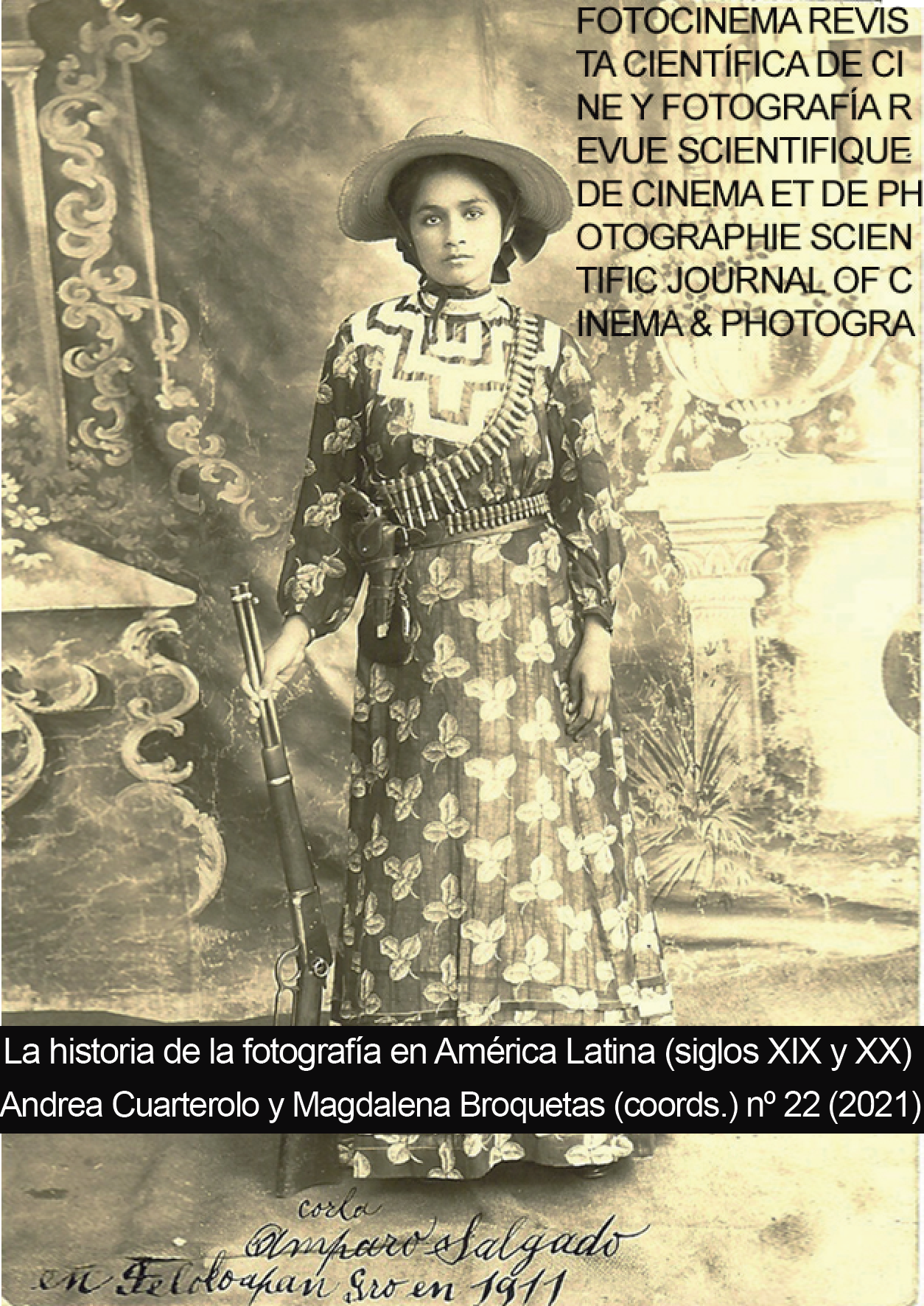Faded images. Unveiling amateur photography of the turn of the century based on the materiality of Josefina Oliver's work
DOI:
https://doi.org/10.24310/Fotocinema.2021.vi22.11666Keywords:
Argentine photography, photographic materiality, amateurism, Josefina Oliver, photographic processes, personal archivesAbstract
The development of portable cameras, easy to use and faster than their predecessors, allowed, at the end of the 19th century, the growth of a very important group for the history of photography: the amateur photographers. This article proposes to analyze the practice of amateurism in Argentina from the production of photographer Josefina Oliver (1875-1956), composed of photographs taken and copied by herself that she attached to her personal diaries, taken between 1892 and 1956. It will be from the analysis of the materiality of these photographs that we will ask ourselves if it is possible to recognize signs of the amateur practice and, from them, to approach the context of production and circulation of knowledge of the amateur photographic environment during the change of century in Argentina. Although the situations registered in the photographs can help us to know their environment and social context, it will be the materiality of these photographs, in which we include the interventions made on them and the deterioration they present at this moment, that will allow us to reveal their working methods and, therefore, the knowledge and access that Oliver had to the photographic environment of the time.
Downloads
Metrics
Publication Facts
Reviewer profiles N/A
Author statements
Indexed in
-
—
- Academic society
- N/A
- Publisher
- Universidad de Málaga
References
Batchen, G. (2001). Each Wild Idea: Writing, Photography, History. Cambridge: The MIT Press.
Bécquer Casaballe, A. & Cuarterolo, M. A. (1985). Imágenes del Río de la Plata. Crónica de la fotografía rioplatense 1840-1940. Buenos Aires: Editorial del Fotógrafo.
Chéroux, C. (2014). La fotografía vernácula. Oaxaca: Ediciones Ve.
Diego, E. de (2018). Tres mujeres en un jardín. Las fotografías de Alice Austen y la paradoja de la imagen documental. Anales De Historia Del Arte, 28, 147-162.
Edwards, E. y Hart, J. (2004). Introduction. Photographs as Objects. En E. Edwards & J. Hart (Ed.), Photographs Objects Histories. On the Materiality of Images. Londres: Routledge.
Frizot, M. (2009). El imaginario fotográfico. Oaxaca: Ediciones Ve.
Fuentes, A. M. (2016). ¿Fotografía o información fotográfica? El impacto de la exhibición en los originales fotográficos. Evolución de los criterios de protección directa para la exposición de originales. Técnicas alternativas de explotación cultural. En J. Cía (Ed.), Conservacio?n de fotografi?as: treinta an?os de ciencia. Conferencia International, Logron?o 2011. Mares de libros.
Gómez, J. (1986). La fotografía en la Argentina. Su historia y evolución en el siglo XIX 1840-1899. Buenos Aires: Abadía Editora.
Gover, C.J. (1988). The Positive Image: Women Photographers in Turn of the Century America. Albany: State University of New York Press.
Lavédrine, B. (2009). Photographs of the Past. Process and Preservation. Los Ángeles: Getty Publications.
Marin, L. (2009). Poder, representación, imagen. Prismas, Revista de historia intelectual, 13, 135-153.
Oliver, J. (1905). Diario 4. Buenos Aires. Manuscrito no publicado.
Pavao, L. (2002). Cuadernos Técnicos. Conservación de Colecciones de Fotografía. Sevilla: Junta de Andalucía, Consejería de Cultura, Instituto Andaluz del Patrimonio Histórico y Editorial Comares.
Pociello, F. (1893) Al lector. Revista Fotográfica Ilustrada del Río de la Plata, 1-2.
Pociello, F. (1898). Tratado completo. La fotografía moderna. Buenos Aires: Enrique Lepage y Cía.
Rosenblum, N. (1997). A World History of Photography. Nueva York: Abbeville Publisher.
Tell, V. (2017). El lado visible. Fotografía y progreso en la Argentina a fines del siglo XIX. Buenos Aires: UNSAM edita.
Viaña, P. M. (2019). Yo, Josefina Oliver. Buenos Aires: Patricia María Viaña.
Downloads
Published
How to Cite
Issue
Section
License
All contents published in Fotocinema Revista científica de cine y fotografía are protected under the Creative Commons Attribution-NonCommercial-ShareAlike 4.0 International (CC BY-NC-SA 4.0) license. All about this license is available in the following link: <http://creativecommons.org/licenses/by-nc-sa/4.0>
Users can copy, use, redistribute, share and exhibit publicly as long as:
- The original source and authorship of the material are cited (Journal, Publisher and URL of the work).
- It is not used for comercial purposes.
- The existence of the license and its especifications are mentioned.
There are two sets of authors’ rights: moral and property rights. Moral rights are perpetual prerogatives, unrenounceable, not-transferable, unalienable, imprescriptible and inembargable. According to authors’ rights legislation, Fotocinema. Revista científica de cine y fotografía recognizes and respects authors moral rights, as well as the ownership of property rights, which will be transferred to University of Malaga in open access. The property rights are referred to the benefits that are gained by the use or the dissemination of works. Fotocinema. Revista científica de cine y fotografía is published in an open access form and it is exclusively licenced by any means for doing or authorising distribution, dissemination, reproduction, , adaptation, translation or arrangement of works.
Authors are responsable for obtaining the necessary permission to use copyrighted images.














13.png)



